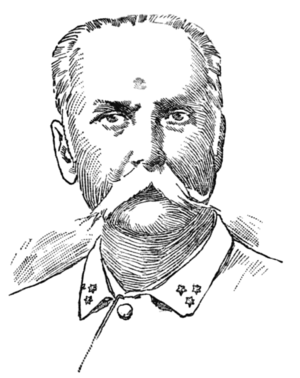Little War (Cuba) facts for kids
Quick facts for kids Little War |
|||||||
|---|---|---|---|---|---|---|---|
| Part of Cuban Independence Wars | |||||||
 Calixto García, the main organizer of the conflict |
|||||||
|
|||||||
| Belligerents | |||||||
| Commanders and leaders | |||||||
| Strength | |||||||
| 8000 | Tens of thousands | ||||||
| Casualties and losses | |||||||
| Hundreds killed | Unknown | ||||||
The Little War (also known as the Guerra Chiquita in Spanish) was a conflict between Cuban rebels and Spain. It was the second of three major wars fought for Cuba's independence. This war began on August 26, 1879, and ended in rebel defeat by September 1880. It happened after the Ten Years' War (1868–78) and before the final war of 1895–98. That last war eventually led to American involvement and Cuba becoming an independent country.
Why the War Started
The Little War began for many of the same reasons as the Ten Years' War. In many ways, it was a continuation of that earlier fight. After the Pact of Zanjón ended the Ten Years' War, a Cuban leader named Calixto Garcia was set free. He traveled to New York City and worked with other revolutionaries. They formed the Cuban Revolutionary Committee.
In 1878, Calixto Garcia wrote a public statement against Spanish rule in Cuba. Many other revolutionary leaders agreed with his ideas. Because of this, the war officially started on August 26, 1879.
The Fight for Freedom
The revolution was led by Calixto García. He was one of the few rebel leaders who had not signed the peace agreement (Pact of Zanjón) that ended the previous war. Other important leaders included José Maceo (whose brother was Antonio Maceo Grajales), Guillermo Moncada, and Emilio Núñez.
The Cuban revolutionaries faced many difficult problems:
- They did not have many experienced leaders besides García.
- They had a serious shortage of weapons and bullets.
- They had no foreign countries helping them.
- The Cuban people were tired from the Ten Years' War. They wanted peace and did not believe victory was possible.
In the western part of Cuba, many rebel leaders were arrested. The remaining leaders were forced to give up their fight throughout 1879 and 1880. By September 1880, the rebels had been completely defeated.
What Happened Next
After the war, Spain had promised to make changes in Cuba. However, these changes were not very effective. The Spanish Constitution of 1876 was put into effect in Cuba in 1881. But this did not change much for most Cubans.
Cuba was allowed to send representatives to the Cortes Generales, which was the Spanish parliament. However, these representatives were often very conservative Cubans. This meant that very little truly changed for the island.
Because there were no real changes, another uprising happened 15 years later. This was the Cuban War of Independence, also known as the War of '95. The experience that the revolutionary generals gained during the Little War helped them greatly in this new conflict. After the War of '95 and the related Spanish–American War, Cuba finally became independent from Spain.
See also
 In Spanish: Guerra Chiquita para niños
In Spanish: Guerra Chiquita para niños

